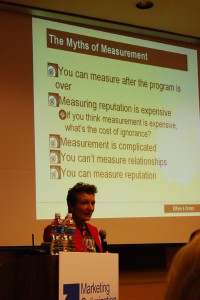 I first heard Katie Delahaye Paine speak at Blog Potomac this summer (thanks to Geoff Livingston for bringing her in to that event) and she just amazed me. Few speakers really enthrall me into what they are speaking about, but at that event Katie sure did. When I saw Katie listed as speaking here at eMetrics Marketing Optimization Summit in Washington DC, I circled that session in red as a must attend and report on.
I first heard Katie Delahaye Paine speak at Blog Potomac this summer (thanks to Geoff Livingston for bringing her in to that event) and she just amazed me. Few speakers really enthrall me into what they are speaking about, but at that event Katie sure did. When I saw Katie listed as speaking here at eMetrics Marketing Optimization Summit in Washington DC, I circled that session in red as a must attend and report on.
Katie’s got a wonderful, straight forward, and to the point way of telling an audience “how it is”. Not in a rude way, but in a way that everyone sitting in those seats understood, what’s worth your time to look at and what’s a waste of your time. She’s got an amazing way to relate to audiences and it was certainly reflected in the questions asked when it was time for Q&A.
Katie started out her discussion talking about “reputation”. “The world ‘reputation’ is so 1999,” Katie began. The term that should be used today is ‘conversation’ and / or ‘having a conversation’. Trying to manage your reputation in a social media environment of today, is just plain silly (and futile), you just can’t.
Both PR Coverage and Social Media (it’s better when they are working together) have a big affect on how companies are perceived and in the end a big on affect on what they are doing. They key though, is to measure both what’s work and what’s not working. Companies also need to understand that people are talking online, they are saying and doing things with brands, products & services, whether you are active in the conversation or not.
Katie then presented the audience with some instances where companies were successfully using social media:
- BestBuy measures 85% lower turnover as a result of its “Blue Shirt” community. 65k of their 85k employees are part of the community, the community has helped retain employees
- State Farm measures it internal blog by the improvement in morale, they put tent cards on tables in cafeteria, re-branded their blog “ask your CEO” morale scores have gone through the roof – they feel “listened too”. Prior to this, it was just their CEO “talking to himself”, no one read the blog.
- ASPCA and MADD can track online donations and increased membership back to its pr efforts and social media efforts
- -Dell measures ROI based on the number of usable ideas generated in Ideastorm
- -On Twitter a start up company got 100 great marketing ideas for free, a woman raised over 6k in day [I believe this might be Beth Canter, but Katie didn’t elaborate, Katie has a session I’ll have a wrap up of on SMG] and a wooden toy maker in NH got a nationwide contract
- -$0 budget YouTube videos about Barack Obama were seen by 120 time the audience than Hilary Clinton’s video
So how do you know what caused the sale, conversion, registration, watching a video, etc.? As it is you don’t, how can you measure your success?
PR & Social Media – The Laws & The Myths
Katie then presented “The Immutable Laws of 21st Century PR Measurement”:
- Banner ad & Popups are not the reason people buy stuff!
- Its not about how many eyeballs, its the right eyeballs
- Its not the media, its the conversation
- Size doesn’t matte so stop screaming, start listening
- “HTS” – How Idiots Track Success [this made me laugh out loud!]
- (we’re use to big big numbers, but its about how you interpret the data)
- -Be who you are and see who is pleased
- -ROI doesn’t mean what you think it does because you can’t divide by zero
Along with the “Laws”, there’s also some “Myths of Measuring””
- You can measure after the program is over
- -Measuring reputation in expensive – if you think measurement is expensive, what’s the cost of ignorance?
- Measurement is complicated
- You can’t measure relationships
- You can measure reputation
Reputation vs. Relationships
 Reputation = experience + actions + history + people
Reputation = experience + actions + history + people
Katie stressed to the audience, you can manage relationships, you can’t manage reputation, to try and do so, especially in social media is pretty much a dead end. Relationships = trust, commitment, satisfaction, control mutuality, exchange / control. Katie explained that most relationship start with exchange, such as money for a product, but the important relationship to create is the communal relationship because its about loyalty.
7 Steps of Reputational ROI
1. Define the”R” – define the expected results
2. Define the “I” – what’s the investment
3. Understand your audiences and what motivates them
4. Define the metrics
5. Determine what you are benchmarking
6. Pick a tool to analyze the data
7. Then to do the “so what”
Listening to the Customers
Traditional PR drove and can still drive conversations on social media forums – its been going on since 1994, nothing new there. What is new, is the blogs and forums are now starting influence the conversations, for example Techcrunch, etc. But what businesses are finding is that these places were not big influencers on the consumers. What influenced the most – was other consumers reviewing products and services. People who actually bought and used the products and placing their thoughts, as opposed to an “expert” espousing “how great/bad” something was.
In a case study that Katie did for a client, their “traditional media” coverage was all bad press about a product, but yet this was one of their most successful products, when they filtered it down to find out why it was successful despite the bad press coverage, it was in the structured customer reviews of the product. The reviews of customers actually using the product were all positive.
Stop Doing Stupid Things, Your Reputation Changes
If you can change the conversation, you can improve your reputation. You can also improve your reputation by first listening and then responding. Negative coverage tends to come from companies, or company representative doing stupid things. This type of negative coverage can harm your reputation, because the web and social media allow things to travel at a fast rate.
Positive issue discussion over time, share of exposure, favorable position can all have an impact on engagement. Katie presented the case of the ASPCA. Rather than just “letting it happen”, they got everyone involved – analytics, marketing, social, etc. They did every possible known way to communicate except advertising. They utilized their online community, blog, myspace friends, youtube channel views, facebooks fans / causes …. but “So what”. None of this is a difference unless its put into context.
The big “Ah-Ha” was “what’s going on with online donations?” Her example of the ASPCA not really being “ahead” of the Michael Vick issue, and just letting legal handle it – they saw no increase in online donations. However, when the news broke about the ASPCA rehabbing the dogs Michael Vick had, they were ahead of the curve in promoting it through all those changes and their online donations grew.
Katie left the audience with this final thought, web analytics is not the tool for everything, media content analysis could be good, or relationship surveys. You need to match the analytical tool to the objective.









Pingback: My